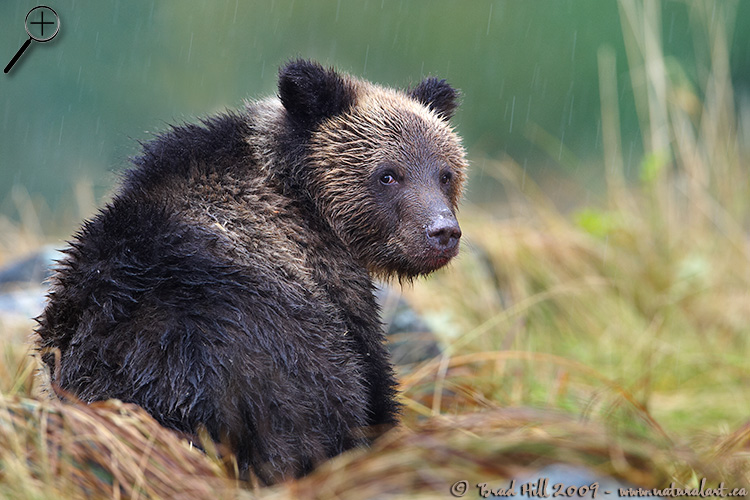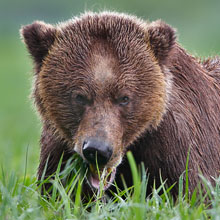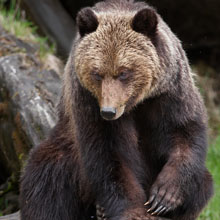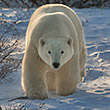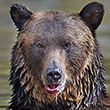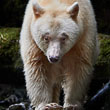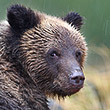Availability: Undetermined - Enquiries?
In the Field
Cute Enough? Northern BC Coast (Great Bear Rainforest), BC. October 1, 2009.
I captured this very wet grizzly cub-of-the-year during my annual autumn pilgrimage into the Great Bear Rainforest of northern BC. This oh-so-cute cub is very different in appearance from other cubs I have encountered in this particular inlet - those in the past had very light faces with dark eyes (kinda like "reverse pandas"), while this one has a very dark face. Its mother had a very dark face as well (hardly surprising) - the cub looked almost like a "mini me" version of ma!
I spend a lot of time thinking about the factors that make an image successful. There are obviously many factors that combine to make an image "work",including technical mastery, many compositional variables, lighting issues, and the uniqueness of the subject matter, among many other variables. When it comes to wildlife, and especially when photographing young animals, simple "cuteness" can play a major role in determining if an image "works" (or sells!) or not. It has been suggested (by behavioural ecologists and other experts in evolutionary theory) that the variables that interact to produce a "cute" animal (large eyes, short snouts, etc.) are universal in the animal kingdom and function to reduce aggression against young animals (often by conspecifics), and in doing so, help ensure that the young survive. While I don't hunt myself, I'd be surprised if many hunters who can easily stomach killing an adult animal would feel the same way about shooting a bear cub, or a fawn, or a coyote pup, etc. (even if it were legal). Cuteness works - in both photography and in nature...
When I was first culling through my images from this trip I was looking at the images with a very technical eye (is the image sharp enough? is the composition strong? etc.). This shot was initially culled out and destined for the trash bin. But, every time I returned to it I stopped to admire the cub and thought it was just so darned cute. There are many things about this image that don't work for me (including have "dual" out-of-focus zones - i.e., both the foreground and background completely out-of-focus - and there are some other distractions in the image), but ultimately the cuteness factor trumps them all and the image does work for me...
This image was captured during my annual "Spirit Bears and the Great Bear Rainforest" Instructional Photo Tour in the autumn of 2009. If you're interested in joining me on one of my photo tours into the Great Bear Rainforest, check out the details on my "Photo Tours" page. My Instructional Photo Tours into the Great Bear Rainforest are run in conjunction with Ocean Light II Adventures - they offer a number of amazing adventure tours (including top-notch bear-viewing tours as well as tours of exploration of the Queen Charlotte Islands) and I highly recommend them!
Behind the Camera
Cute Enough? Northern BC Coast (Great Bear Rainforest), BC. October 1, 2009.
Digital Capture; Compressed RAW (NEF) 14-bit format; ISO 250.
Nikon D3 with Nikkor 600 mm f/4G ED-IF AF-S VR lens - handheld from floating Zodiac. VR on and in "Normal" mode.
1/160s @ f5.6; -0.67 stop compensation from matrix-metered exposure setting of camera.
At the Computer
Cute Enough? Northern BC Coast (Great Bear Rainforest), BC. October 1, 2009.
RAW Conversion to 16-bit TIFF, including first-pass/capture sharpening using Phase One's Capture One Pro 4.8. Three RAW conversions at different exposure settings. Exposure settings of +0.25 stops (for background and foreground) through to +0.85 stops (for face of the cub).
Further digital corrections on 16-bit TIFF file using Adobe's Photoshop CS4. Photoshop adjustments included compositing and masking of 3 exposure versions, selective colour saturation and desaturation, selective exposure curve adjustment, and selective sharpening for web output.
Conservation
Cute Enough? Northern BC Coast (Great Bear Rainforest), BC. October 1, 2009.
Ten percent of the revenue generated by this image will be donated to Raincoast*.
Species Status in Canada**: Special Concern (May 2002).
While Grizzly Bears (Ursus arctos) are not technically listed as "Endangered" in Canada, they have been extirpated from most of their historical range. Grizzly Bears are far more sensitive to intrusion/disturbance in their habitat than are Black Bears and are being increasingly forced into marginal habitat by human encroachment. The Great Bear Rainforest along the central and northern coast of British Columbia is one of the last strongholds of the Grizzly Bear in Canada, and even this population is coming under increasing pressure.
On December 18, 2017 the government of British Columbia banned grizzly hunting across the entire province. This major conservation victory came after decades of tireless work by many dedicated conservationists and ecologists and, most importantly, it reflects the opinion of the vast majority of British Columbians. And, it means that AT LEAST while the current government remains in power grizzlies are finally "safe" in British Columbia.
Now that we've at least temporarily won the battle to save grizzlies in BC, it's time to re-focus our efforts toward protecting ALL of BC's carnivores, including Gray Wolves, Black Bears, Cougars, Wolverines, and more! Simply put, there are no ecological, economic, or ethical arguments supporting the trophy hunting of carnivores.
In a great first step towards ending the hunting of carnivores throughout BC the Raincoast Conservation Foundation has developed a program designed to protect ALL carnivores within the Great Bear Rainforest. Details about this program can be found on this page on Raincoast's website. Check it out and, better yet, make a donation to help Raincoast purchase the remaining commercial hunting tenures in the Great Bear!
*The Raincoast Conservation Society (and Foundation) is an effective and efficient organization that has been fighting for protection of this unique habitat. If you are looking for a meaningful way to contribute to the conservation of this amazing ecosystem, Raincoast will provide maximal "bang" for your conservation dollars.
**as determined by COSEWIC: The Committee on the Status of Endangered Wildlife in Canada












